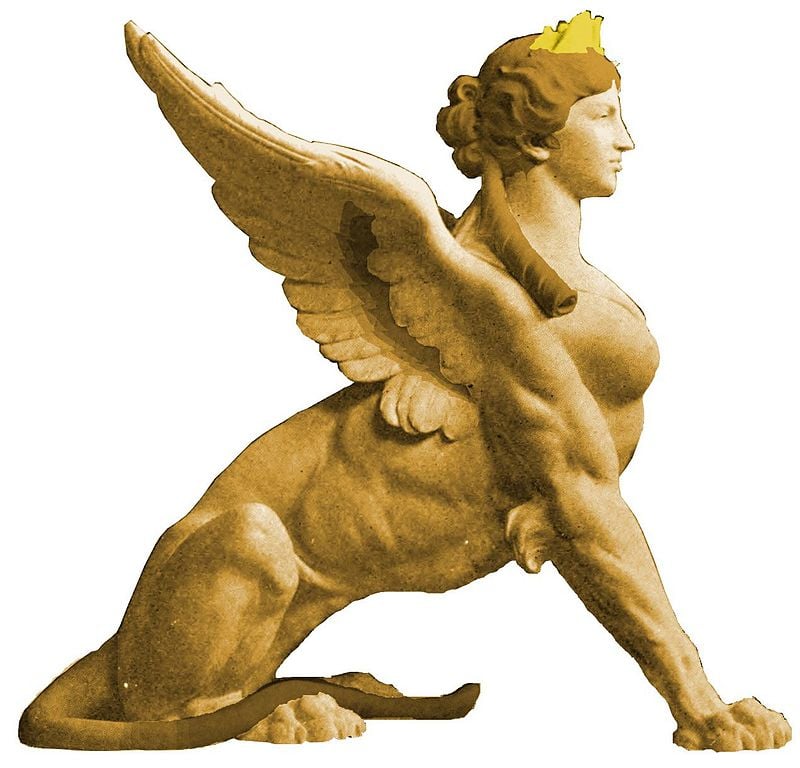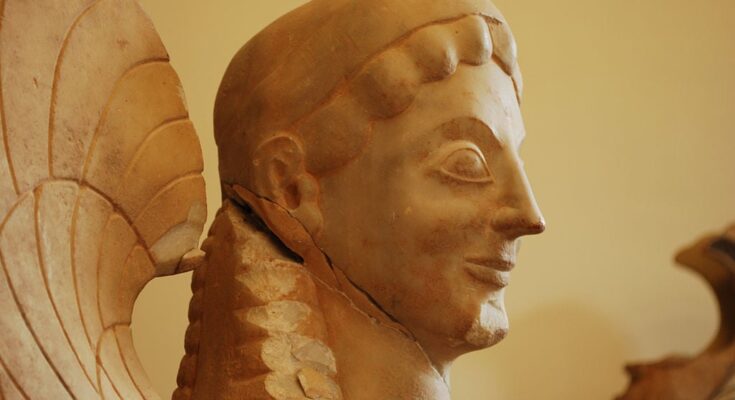Of all the iconic figures from ancient times, the Sphinx stands out, depicted in various forms across Greek, Near Eastern, and Asian civilizations. This powerful symbol often features a lion’s body, a human head—either male or female—and the wings of a giant bird.
In ancient Egypt, of course, the iconic 66-foot-tall statue guarding the Great Pyramid of Giza has male characteristics and was designed to be a symbol of great physical power and might.

However, across the Mediterranean, the Ancient Greek playwright Sophocles, in his tragic play Oedipus Rex, described the Sphinx as a female “monster” with a lion’s body, a bird’s wings, a serpent’s tail — and a disturbing amount of wisdom. The riddles she posed puzzled and infuriated mortal men — and were a threat to their very existence.
This unforgettable figure is portrayed as a being that lived outside the city of Thebes.
She was the daughter of the god Orthus, and either the goddess Echidna or Chimera, and asked a riddle to all travelers, in order to let them pass.
After posing almost impossibly difficult riddles to mortals before she would let them pass her, she eats anyone who cannot correctly answer her most burning question: “What goes on four legs in the morning, two feet at noon and three in the evening?”
Of course, we know, after having learned from Oedipus’ example, that this is “a man,” who crawls as an infant, then walks as an adult and uses a cane as an elder.
Some maintain that there was a second riddle following the first, in which the Sphinx asked travelers “There are two sisters; one gives birth to the other, who in turn gives birth to the first. Who are they?”
The correct answer is “Day and Night”; these two words are both feminine in the Greek language, researchers from greekmythology.com note. After Oedipus correctly answered both this and the first question, the Sphinx promptly killed herself.
When Oedipus is thereby enabled to pass through to the city, he eventually is made King there, marrying a woman who turned out to be his mother, Iacosta — but, as the author of “Mythology and Fiction Explained” says, “that’s a story for another time.”
Were men so threatened by female power that they were made into monsters?
According to Sophocles, the Sphinx is so beside herself after Oedipus guesses correctly, that she feels she has no alternative other than to throw herself off a cliff.
The Sphinx who posed these difficult riddles was only one of several Greek mythological monsters who were portrayed as female, including Scylla and Charybdis, Medusa, and Lamia.
But how could this be? Did women pose such a threat to men, were their verbal and emotional powers threatening enough, that Sophocles and the reciters of Greek mythological tales gave female form to these frightening monsters?
“Men’s fear of women’s destructive potential”
In a recent story in Smithsonian magazine, author Nora McGreevy recalls remarks made by classicist Debbie Felton in an essay from 2013, which states that such tales, passed down through the generations, “spoke to men’s fear of women’s destructive potential. The myths then, to a certain extent, fulfill a male fantasy of conquering and controlling the female.”
Journalist and critic Jess Zimmerman, writing in a collection of essays entitled “Women and Other Monsters: Building a New Mythology,” says “Women have been monsters, and monsters have been women, in centuries’ worth of stories, because stories are a way to encode these expectations and pass them on.”
Zimmerman theorizes that this is to be expected in cultures that punished women for their native intelligence, and for “keeping knowledge to themselves.”
Sphinx is an embodiment of the maxim “knowledge is power”
As she states — and as every educated person knows — knowledge indeed is power. This is one of the reasons, she says, that for so long in human history, males have excluded females from formal education.
“The story of the Sphinx is the story of a woman with questions men can’t answer,” Zimmerman states. “Men didn’t take that any better in the fifth century B.C. than they do now.”
Interestingly, a contemporary poet, the late American writer Muriel Rukeyser, who lived from December 15, 1913 to February 12, 1980, reimagined the significance of such female creatures – who had, after all, been created by men.
In her interpretation, the Sphinx’s confrontation with Oedipus unfolds very differently.
“Breaking Open”
The following passage was originally published in Rukeyser’s 1973 work “Breaking Open:”
“Long afterward, Oedipus, old and blinded, walked the
roads. He smelled a familiar smell. It was
the Sphinx. Oedipus said, “I want to ask one question.
Why didn’t I recognize my mother?”
“You gave the wrong answer,” said the Sphinx.
“But that was what
made everything possible,” said Oedipus.
“No,” she said.
“When I asked, What walks on four legs in the morning,
two at noon, and three in the evening, you answered,
Man. You didn’t say anything about woman.”
“When you say Man,” said Oedipus, “you include women
too. Everyone knows that.”
She said, “That’s what
you think.”
A changing of the guard for Greek deities
Some researchers believe that the death of the Sphinx represents the way in which the ancient Greeks made the transition from their oldest traditional religious practices, represented by the Sphinx, to the new ones, including the establishment of the Olympian deities, represented by Oedipus.
It was necessary to kill off the Sphinx in order to impose the new deities, they say.
But it is hard to see the repeated deaths of the female deities — and even the monsters — of Ancient Greece, and not believe that there was something else going on there.
Something that has everything to do with keeping women in their place and nothing to do with a changing of the guard amongst the gods and goddesses in power.



